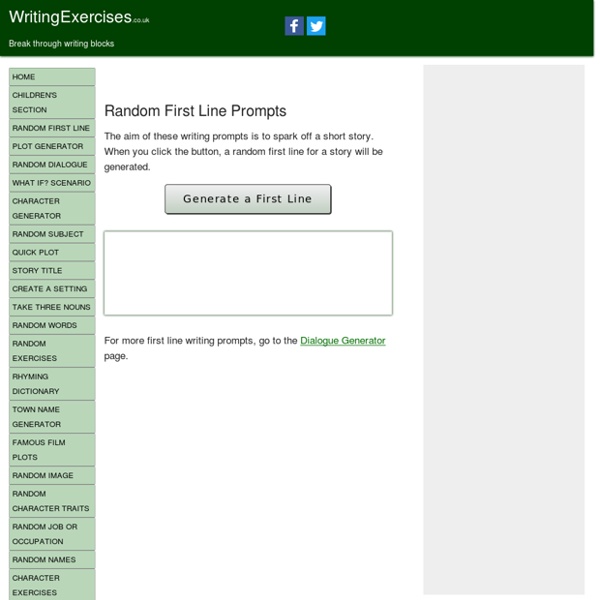



http://writingexercises.co.uk/firstlinegenerator.php
Related: Writing/Books • Writing • WritingEvergreen Content Ideas: The Complete List For Your Blog A good tweet peaks at 18 minutes. An evergreen blog post lasts for years. It’s crazy to see the disparity between two pieces of content that we all create on a regular basis. It’s a little reassuring, too, that some things we make online have a chance to endure.
Create-a-Story By Craig Gill Age Range: 7 to 11 This resource can be used to help children who may lack ideas during creative writing lessons. It consists of four charts, which contain 81 characters, 81 places, 81 situations and 81 objects. Example of Discussion Text "School Uniform" - Free English Course What is discussion text? Discussion genres is a text which presents a problematic discourse. How an example of discussion text conveys a problematic issue? This problem will be debated from different points of view.
Rilke on Writing and What It Takes to Be an Artist Even more complex and nuanced than the question of how to be a good writer, which has elicited answers from some of humanity’s most beloved authors, is the question of why be a writer at all — why, that is, do great writers write? Among the most memorable and invigorating answers are those sprung forth by W.H. Auden, Jennifer Egan, Pablo Neruda, Joan Didion, David Foster Wallace, Italo Calvino, and William Faulkner. But the finest, richest, truest answer of all comes from Rainer Maria Rilke (December 4, 1875–December 29, 1926) in Letters to a Young Poet (public library) — those invaluable packets of wisdom on writing and life, which Rilke bequeathed to a 19-year-old cadet and budding poet named Franz Xaver Kappus. In the very first installment from their now-iconic correspondence, the young poet shares some of his writing with his mentor and extends the simple, enormously difficult question of how one knows one is a writer.
Theme Poems In this online tool, elementary students can write poems based on shapes from five different categories: Nature, School, Sports, Celebrations, and Shapes. Within these categories, 32 different shapes are included. By selecting a shape, students are learning how to focus their writing on a particular topic or theme. Search: "writing assignment" Writing Assignments: Write An Eye-Witness Report 09.05.2014writing Trial witnesses are remarkably unreliable. Memory and recall are imperfect and malleable and can be manipulated by questioning.
How to Self-Publish a Bestseller: Publishing 3.0 My most recent book, “Choose Yourself!” sold 53,000 copies since it’s release on June 3 [update 2016 – over 500,000 copies], hit the Wall Street Journal Bestseller list, was No. 1 on Amazon for all non-fiction books for a few days and is still flirting with No. 1 in its various categories. This post is about what I did differently, why I did it differently, and how I think anyone can do this to self-publish a bestseller.
A Range of Free, Downloadable, Writing Templates – EDTECH 4 BEGINNERS I’ve made some writing frames, which are completely free to download (just right click and ‘save image as’, or find high quality PDFs by clicking this link). I hope they are useful 1) Narrow lined paper template: 2) Medium lined paper template: 3) Postcard writing template:
25 Great Essay topics for Students Writing an essay can be a daunting task for both teachers and students in terms of creating and crafting a high quality essay, and finally editing and grading them. It seems though we may have overlooked one of the toughest steps in writing an essay and that is actually selecting an appropriate and interesting topic for your students. Thankfully I have put together a list of 25 great essay topics that might just make that process a little easier. Enjoy. How to Write Diploma, Master or PhD Thesis? How to Write Diploma, Master or PhD Thesis? Guidelines for writing a diploma, master or PhD thesis In this article I will try to briefly explain how to organize the contents of your thesis, mainly the outline what should be each chapter (or section) about. The guidelines in this article are mainly relevant to Computer Science, Computer Engineering, Computer Architecture subjects but I guess they can apply for other engineering (such as Electrical Engineering, Mechanical Engineering) and science disciplines. The structure of you thesis is good to follow the following structure: 1.
Teach English Writing: Videos Write Story Summaries Writing Skills: idea, word choice, sentence fluency, conventions, organisation Short videos with interesting plots make great prompts for an ESL writing class. Here are 5 videos which can help students learn English writing skills. What makes a good video prompt?